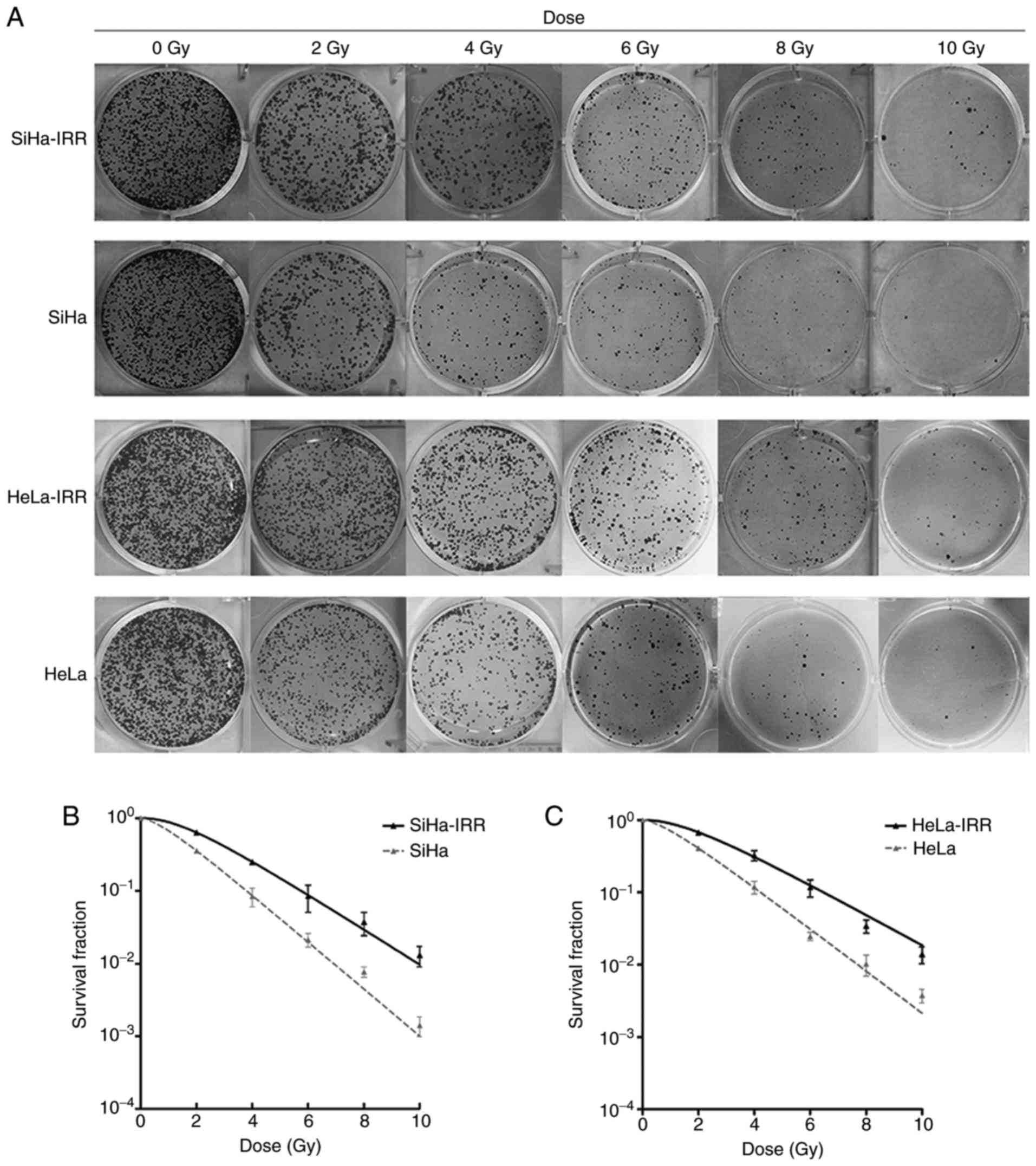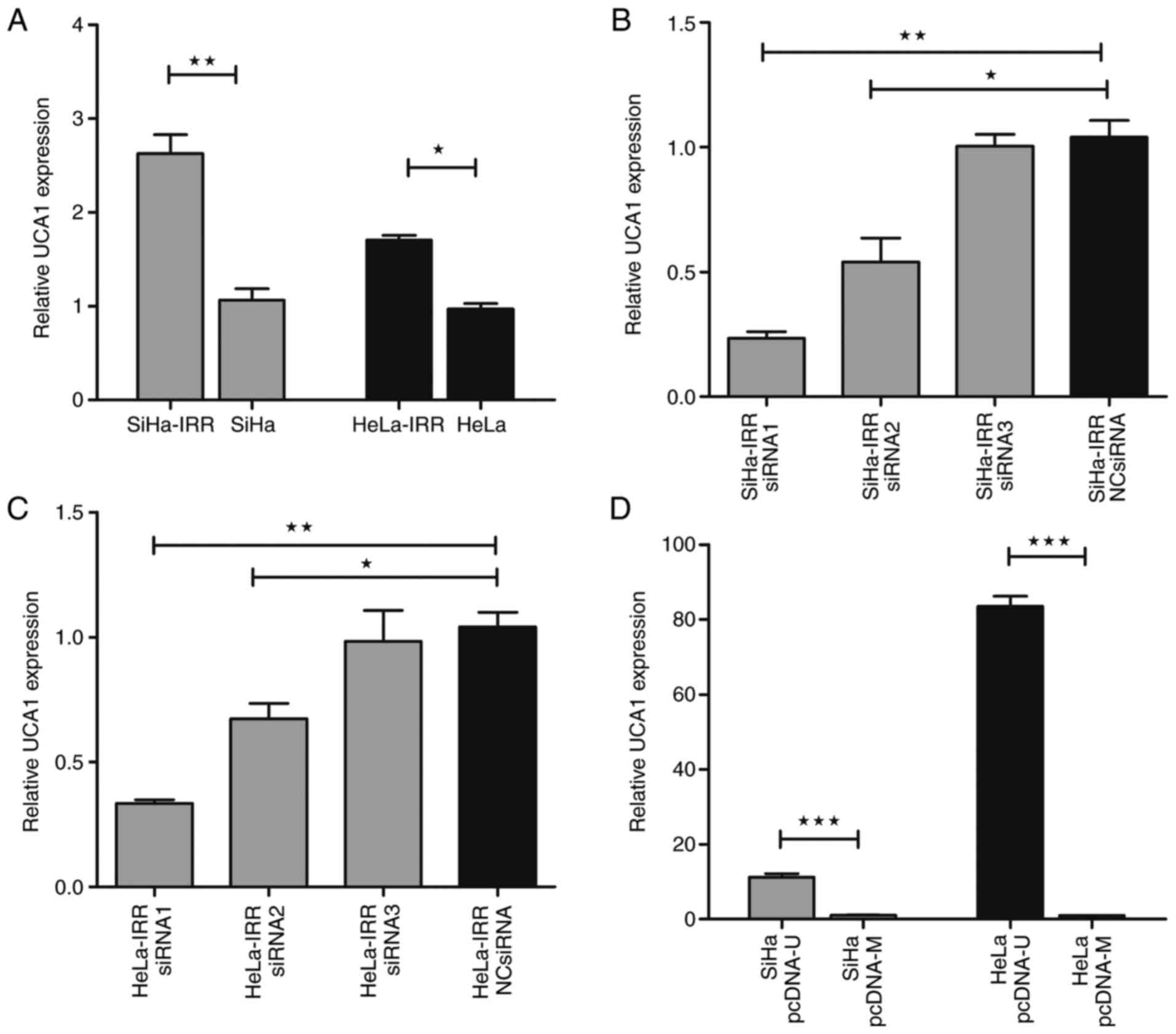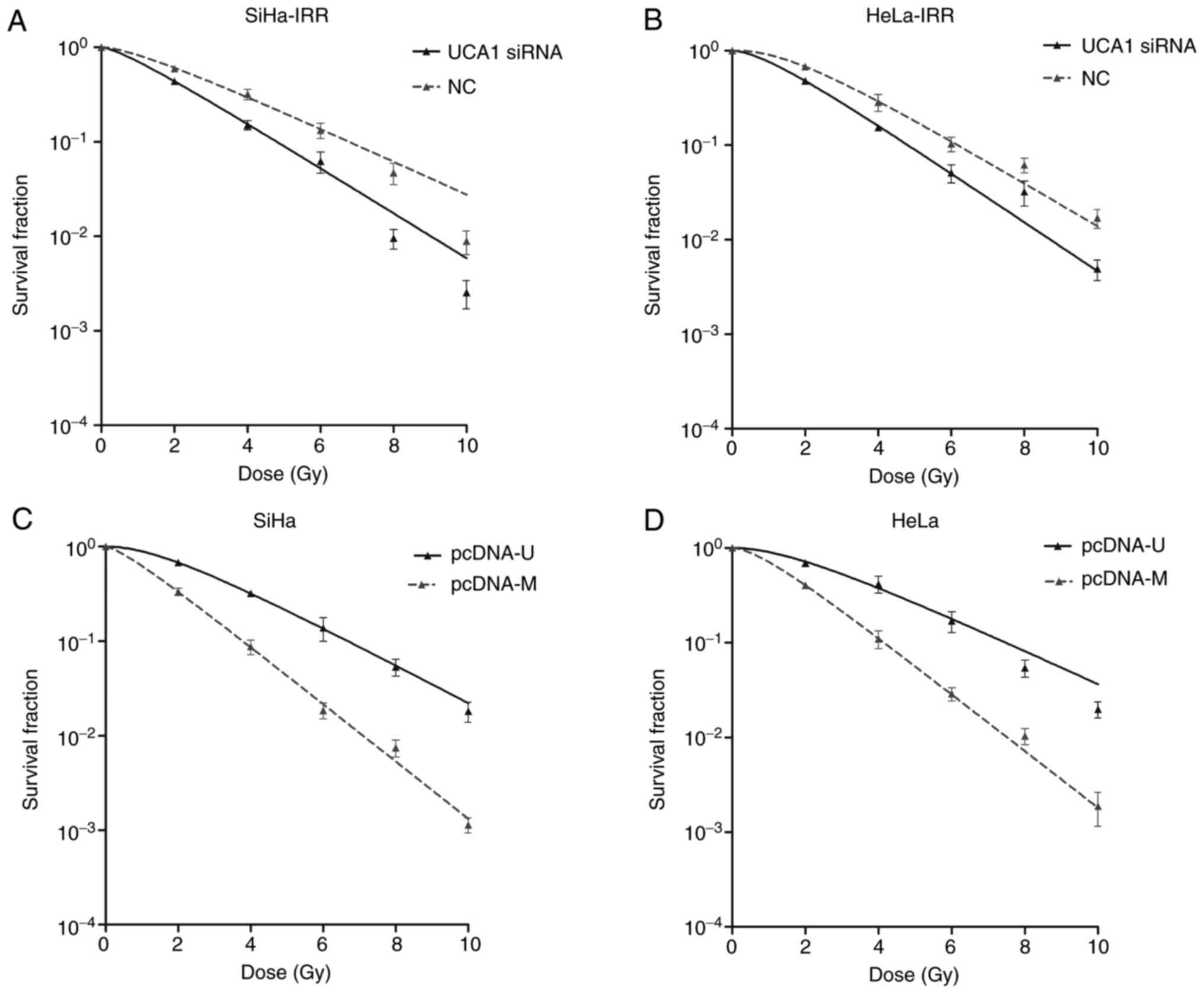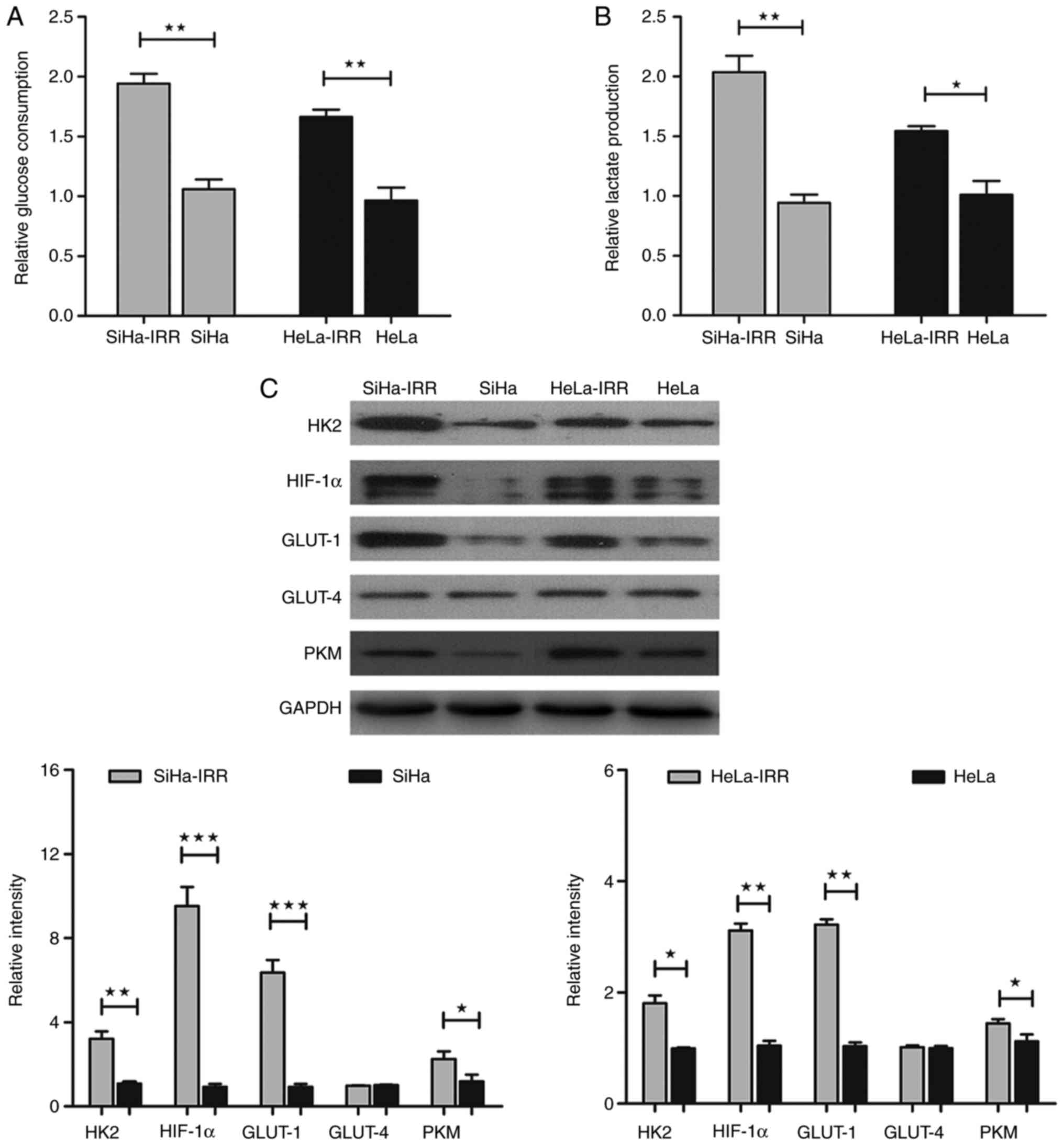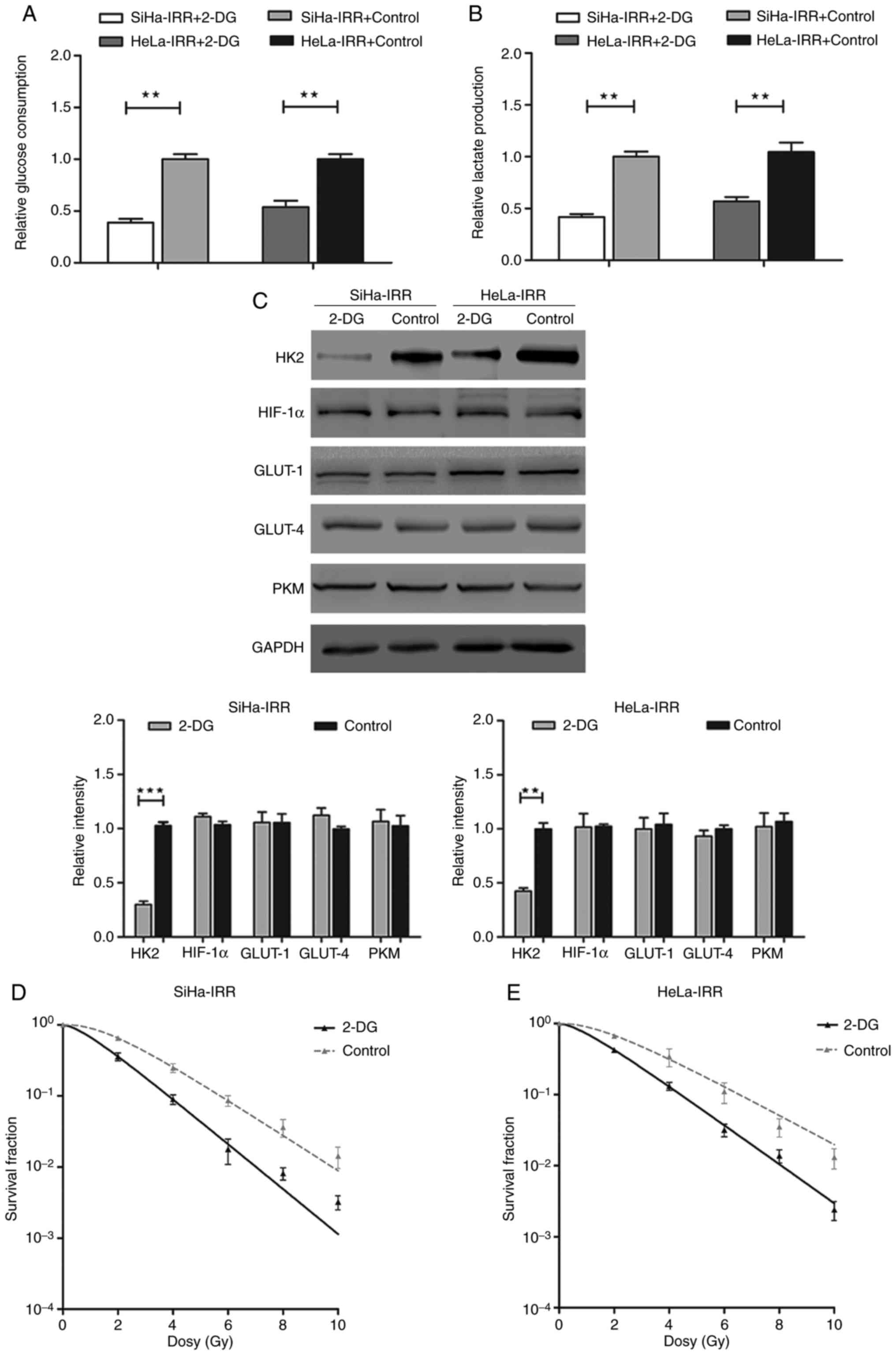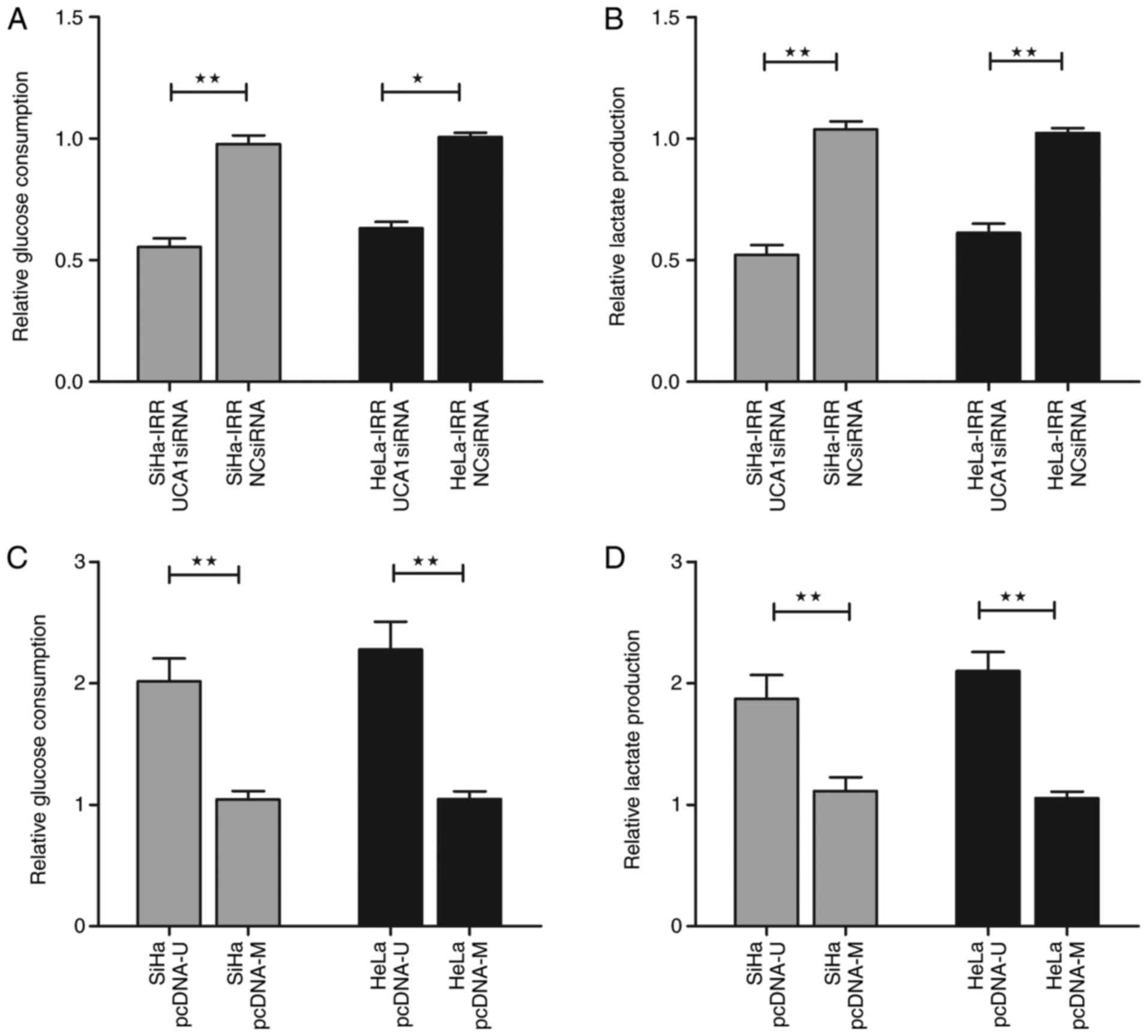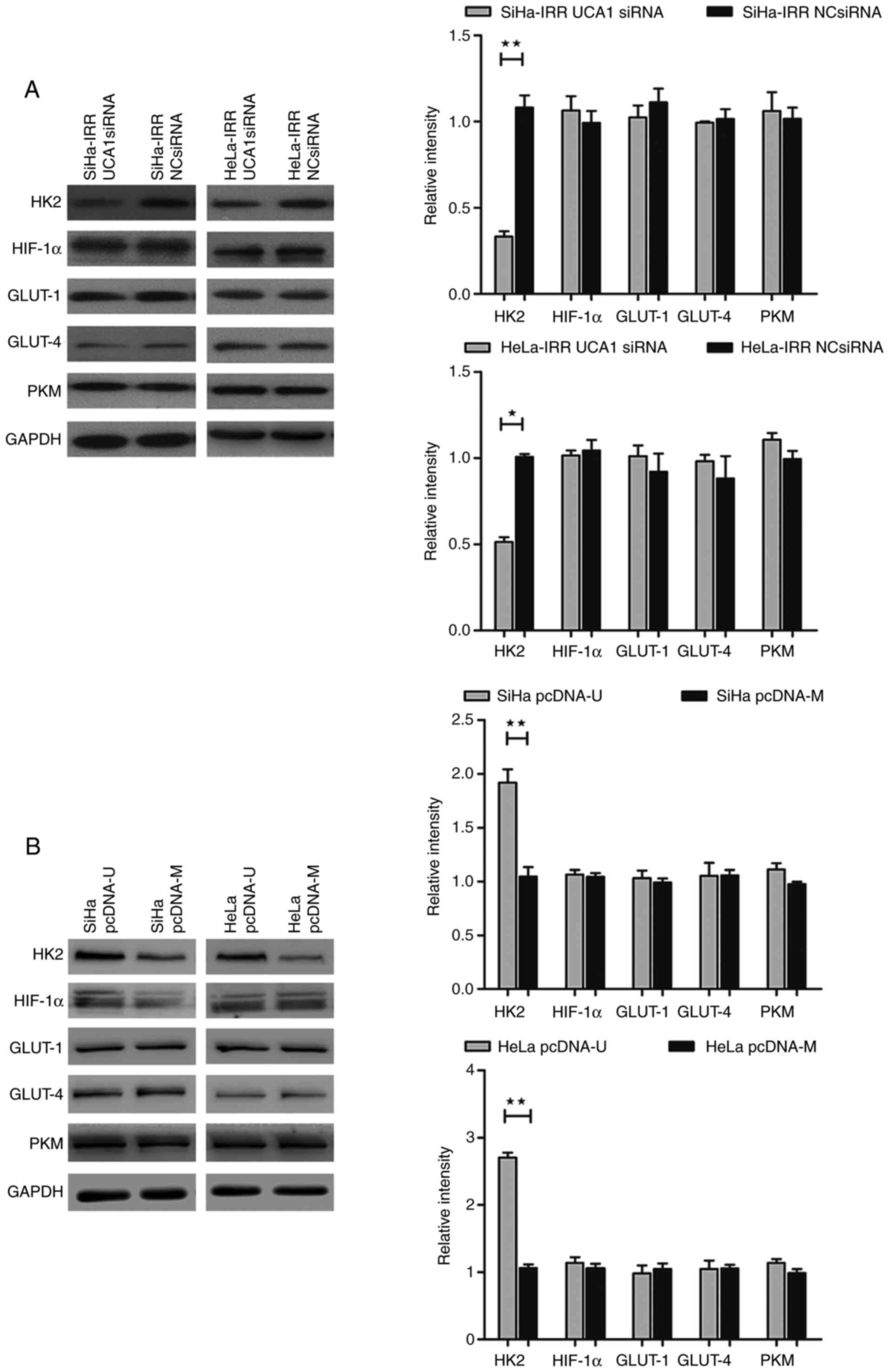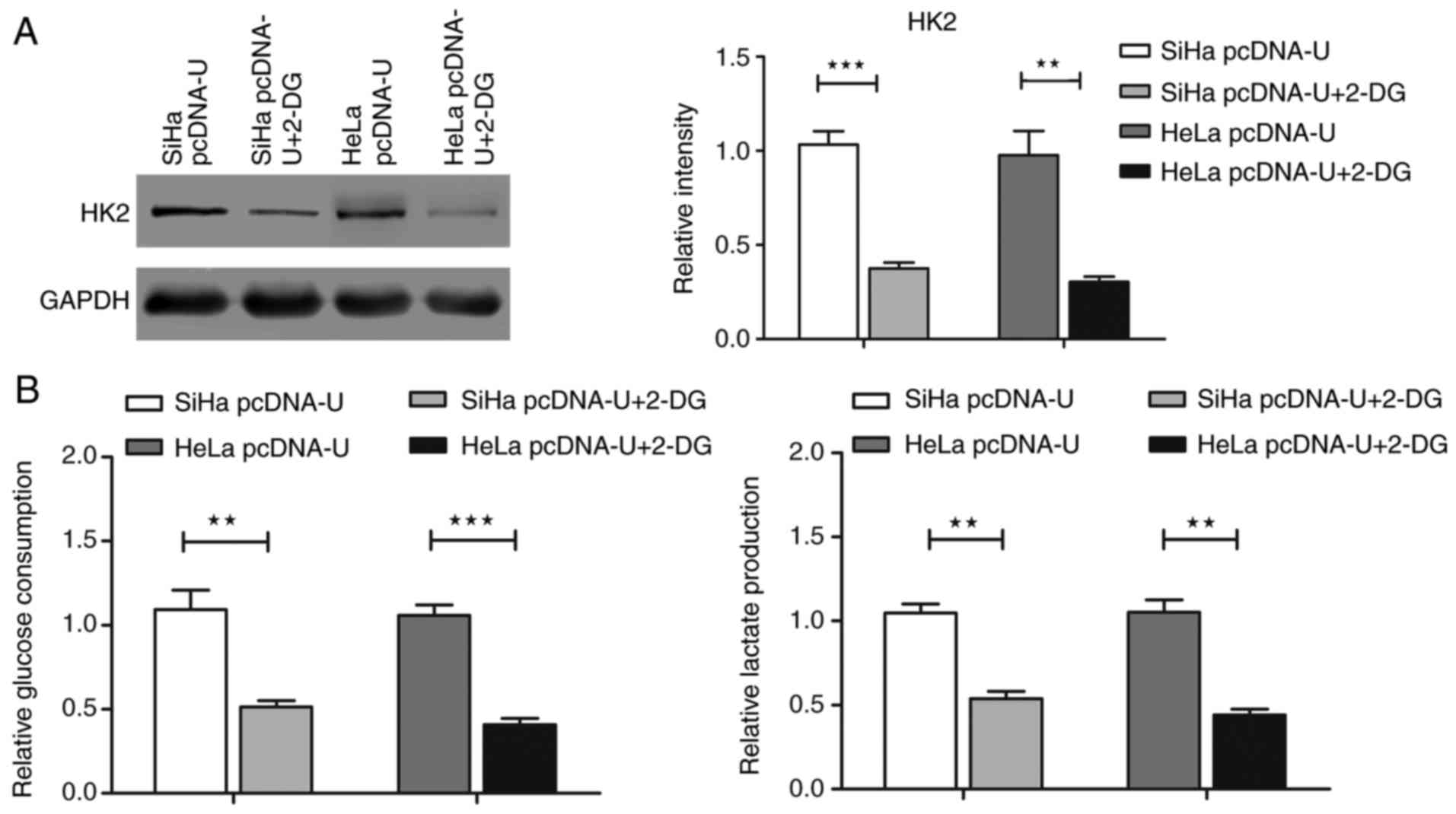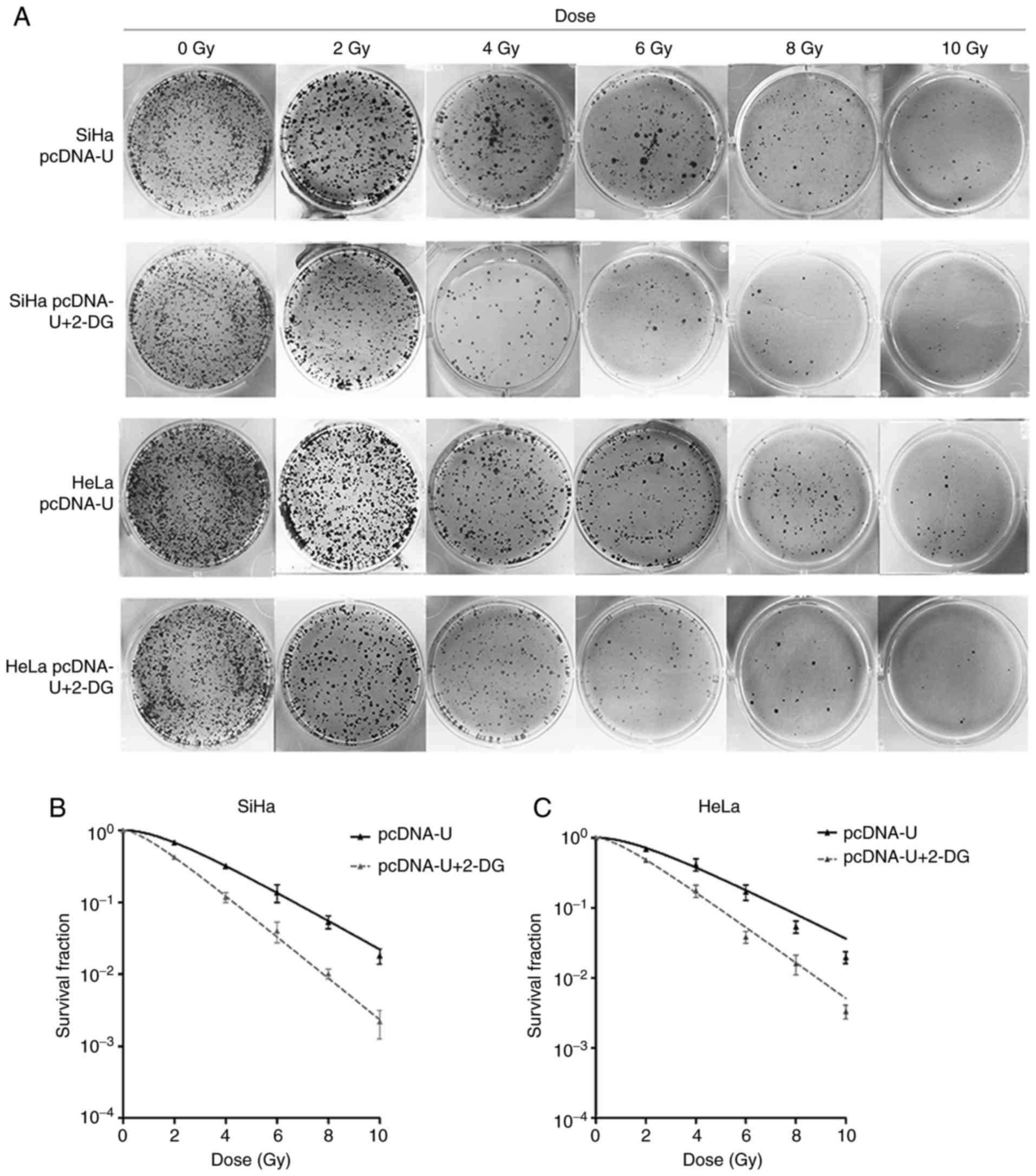Long non‑coding RNA urothelial cancer associated 1 regulates radioresistance via the hexokinase 2/glycolytic pathway in cervical cancer
- Authors:
- Published online on: July 13, 2018 https://doi.org/10.3892/ijmm.2018.3778
- Pages: 2247-2259
Abstract
Introduction
Cervical cancer is the third most common tumor type and the fourth leading cause of cancer-associated mortality in women globally (1). It is estimated that 530,000 new cases of cervical cancer and 270,000 cases of cervical cancer-associated mortality occur annually worldwide (2). Radiotherapy (RT) as the predominant therapeutic strategy or as an adjuvant treatment can be applied to all stages of cervical cancer. Notably, v44% of patients suffer from a relapse in cancer, among which, 35% of the recurrent tumors are locoregional (3). The failure of RT is mainly attributed to radioresistance, which is present in a subpopulation of radioresistant cancer cells (4,5). However, the underlying biological mechanisms that cause radioresistance remain unclear. Therefore, there is an urgent requirement to investigate the mechanisms governing radioresistance in cervical cancer.
The development of human genome sequencing technology has allowed long noncoding RNAs (lncRNAs) to be studied. LncRNAs are a novel class of mRNA-like transcripts, which contain >200 nucleotides, and are involved in numerous cellular events (6). The identification of lncRNAs has been considered a novel breakthrough to better understand the initiation and progression of cancer (7). Notably, lncRNAs are also implicated in RT and chemotherapy resistance (8).
Urothelial cancer associated 1 (UCA1), also known as cancer-upregulated drug resistant, was initially discovered and researched in bladder cancer (9). Subsequently, the abnormal expression of UCA1 has been reported in several other malignancies, where it functions as an oncogenic lncRNA (10). Furthermore, UCA1 abundance is correlated with resistance to RT in prostate cancer (11) and chemotherapy in various types of cancer (12).
Therapeutic resistance is a complex, multifactorial process. Previous studies have revealed that the increased glycolysis of cancer cells is strongly correlated with radioresistance (13,14). In cervical cancer, the interaction between glucose metabolism and hypoxia has been proposed to be the root of radioresistance (15). Alteration in glucose metabolism is one of the main characteristics of cancer; most tumor cells exhibit increased glycolysis and decreased mitochondrial oxidative phosphorylation. This common phenomenon is called ‘aerobic glycolysis’ or the ‘Warburg effect’ (16).
To the best of our knowledge, the biological role of UCA1 in cervical cancer RT response has yet to be elucidated. The present study tested the hypothesis that UCA1 was involved in the radioresistance of cervical cancer cells via theglycolytic pathway. The results demonstrated that the SiHa-irradiation-resistant (IRR) and HeLa-IRR cell lines exhibited significantly increased UCA1 expression and glycolysis compared with in the parental cell lines. Furthermore, UCA1 knockdown improved radiosensitivity, whereas UCA1 overexpression induced radioresistance. Inhibition of glycolysis restored the sensitivity of IRR cells to irradiation. The present data also suggested that UCA1 contributed to RT resistance through the glycolytic pathway. By investigating the proteins associated with glycolysis, it was revealed that hexokinase 2 (HK2) was the crucial regulator in this process.
Materials and methods
Cell culture and drug treatment
Human cervical cancer cell lines HeLa and SiHa were purchased from the Cell Resource Center of Shanghai Institute of Life Sciences, Chinese Academy of Sciences (Shanghai, China). HeLa and Siha cell lines were authenticated by short tandem repeat profiling. The cervical cancer cells were cultured in Dulbecco's modified Eagle's medium (Gibco; Thermo Fisher Scientific, Inc., Waltham, MA, USA) supplemented with 10% fetal bovine serum (Biological Industries, Kibbutz Beit-Haemek, Israel) in a humidified incubator containing 5% CO2 at 37°C. The glycolysis inhibitor 2-deoxy-D-glucose (2-DG) was purchased from Selleck Chemicals (Houston, TX, USA) and was dissolved in deionized water at a concentration of 5 mM according to the manufacturer's protocol; treatment of cells with deionized water only was considered the control group. Cells were treated with 5 mM 2-DG for 24 h in an incubator containing 5% CO2 at 37°C to inhibit glycolysis.
Establishment of IRR cervical cancer cells
SiHa and HeLa cells (5×105) plated in 25 cm2 culture flasks were irradiated with 2 Gy X-ray generated by 6 MeV β-rays from a Linear Accelerator (Siemens AG, Berlin, German) with a 1.0-cm tissue compensation membrane. Following irradiation, the cells with renewed culture medium were immediately placed in an incubator containing 5% CO2 at 37°C. The cells were irradiated 5 days per week, and were then allowed 7–10 days recovery prior to further irradiation. After cells had been exposed to a total dose of 76 Gy irradiation, a clonogenic assay was used to determine the level of resistance. The parental cells, which underwent mock irradiation (exposed to 0 Gy irradiation), were cultured under the same conditions. The follow-up experiments were conducted 1 month after the last irradiation.
Clonogenic survival assay
Cells (1,000, 2,000, 4,000, 6,000, 8,000 and 10,000) were seeded into 6-well plates; a total of 24 h after being plated, the cells were irradiated at doses of 0, 2, 4, 6, 8 and 10 Gy, respectively. Subsequently, the cells were placed in an incubator containing 5% CO2 at 37°C to allow colonies to form. After 10–14 days, colonies were fixed with 4% paraformaldehyde for 15 min and stained with 0.1% crystal violet for 15 min at room temperature. Colonies containing >50 cells were counted and considered clonogenic survivors. Survival fraction = Number of colonies/number of cells seeded × plating efficiency of the control group. The control group plating efficiency was the ratio between colonies formed and number of cells plated. The survival fraction curve was plotted according to the single-hit multitarget formula: S = 1 − (1−e−D/D0)N (17). The experiments were performed three times.
RNA isolation and reverse transcription-quantitative polymerase chain reaction (RT-qPCR)
Total RNA was extracted from the cells using RNAiso Plus (cat. no. 9108; Takara Biotechnology Co., Ltd., Dalian, China). Using the RT-PCR kit (cat. no. RR047A; Takara Biotechnology Co., Ltd.) RNA was reverse transcribed into cDNA, according to the manufacturer's protocol. UCA1 expression was detected using SYBR® Premix Ex Taq™ II (cat. no. RR820A; Takara Biotechnology Co., Ltd.) according to the manufacturer's protocol, and GAPDH expression was used as an internal control. Thermocycling conditions for PCR were as follows: 95°C for 30 sec, followed by 40 cycles at 95°C for 5 sec and 60°C for 30 sec. The 2−ΔΔCq method (18) was used to calculate the results. Three independent experiments were performed. Primers were synthesized by Sangon Biotech Co., Ltd. (Shanghai, China). The primer sequences are listed in Table I.
Western blotting
Cells were lysed in cell lysis buffer (cat. no. CW2333S; CWBIO, Beijing, China) supplemented with 1% protease inhibitor (cat. no. CW2383; CWBIO). The cell lysate was centrifuged at 15,000 × g for 15 min at 4°C. After centrifugation, the supernatant was collected. Bicinchoninic acid assay was applied to quantify protein concentration. Samples containing 20 µg total protein were separated by 10% SDS-PAGE and then transferred to a polyvinylidene fluoride membranes (Roche Diagnostics, Shanghai, China). The membranes were then incubated in blocking solution containing Tris-buffered saline containing 0.1% Tween (TBST; pH 7.4) and 5% (mass-volume concentration) low-fat milk at room temperature for 1 h. After being washed three times in TBST, the membranes were incubated with rabbit polyclonal immunoglobulin G anti-human antibodies: HK2 (1:1,000, cat. no. 22029-1-AP), hypoxia-inducible factor 1α (HIF-1α; 1:400, cat. no. 20960-1-AP), glucose transporter (GLUT)-1 (1:1,000, cat. no. 21829-1-AP), GLUT-4 (1:400, cat. no. 21048-1-AP), pyruvate kinase muscle isozyme M2 (PKM2; 1:1,000, cat. no. 15822-1-AP) and GAPDH (1:4,000, cat. no. 10494-1-AP) (ProteinTech Group, Inc., Chicago, IL, USA) overnight at 4°C. Subsequently, the membranes were incubated with an horseradish peroxidase-conjugated anti-rabbit secondary antibody (1:2,000; cat. no. sc-2357; Santa Cruz Biotechnology, Inc., Dallas, TX, USA) at room temperature for 1 h. After being treated with enhanced chemiluminescence Plus solution (cat. no. WBKLS0010; EMD Millipore, Billerica, MA, USA), the protein bands were visualized through exposure to X-ray film. Densitometric analysis was performed using ImageJ bundled with 64-bit Java 1.8.0_112 software (National Institutes of Health, Bethesda, MD, USA) and expression was normalized to GAPDH housekeeping protein expression.
Evaluation of glucose consumption and lactate production
To evaluate glucose and lactate concentration, glucose (cat. no. GOGA20; Sigma-Aldrich; Merck KGaA, Darmstadt, Germany) and lactate assay kits (cat. no. K667-100; BioVision, Inc., Milpitas, CA, USA) were used, according to the manufacturers' protocols. Glucose and lactate concentrations were determined according to a standard curve, and were normalized to cell number. Glucose consumption was defined as the difference in glucose concentrations between the original media and the media after 24 h of cell culture.
Transfection of cervical cancer cell lines
A total of 3×105 cells were seeded into 6-well plates. SiHa-IRR and HeLa-IRR cells were transfected with 5 mM plasmids and small interfering (si)RNAs using Lipofectamine® 2000 (cat. no. 11668-019; Invitrogen; Thermo Fisher Scientific, Inc.) at room temperature, according to the manufacturer's protocol. Cells that were transfected with a mock plasmid or negative control siRNA were considered control cells. The full-length UCA1 sequence (Suzhou GenePharma Co., Ltd.) was cloned into a pcDNA3.1 (+) vector (Suzhou GenePharma Co., Ltd., Suzhou, China) for overexpression of UCA1. For the knockdown of UCA1, three siRNAs against UCA1 (Suzhou GenePharma Co., Ltd.) were used (Table I). A total of 24 or 48 h post-transfection, cells were harvested and subjected to the subsequent experiments. Cells were simultaneously transfected with the UCA1 over-expression plasmid and treated with 2-DG; briefly, a total of 24 h post-transfection with pcDNA3.1/UCA1 (pcDNA-U), the parental cells were treated with 5 mM 2-DG for 24 h, and were then irradiated at doses of 0, 2, 4, 6, 8 and 10 Gy.
Statistical analysis
All data were analyzed using SPSS standard version 13.0 software (SPSS, Inc., Chicago, IL, USA). Student's t-test and one-way analysis of variance followed by the Bonferroni post hoc test were used to evaluate comparisons between groups. P<0.05 was considered to indicate a statistically significant difference.
Results
Establishment of IRR cell lines
After low-dose long-term irradiation to a total dose of 76 Gy, IRR cells were separated from the parental cell populations. A clonogenic assay was performed to validate the radioresistance of the subpopulation cells (Fig. 1). The IRR cells (SiHa-IRR and HeLa-IRR) exhibited increases in survival fraction at 2, 4, 6, 8 and 10 Gy compared with the SiHa and HeLa parental cells (Fig. 1B and C). Furthermore, radiobiological parameters of the SiHa-IRR and HeLa-IRR cells were greater than those of the SiHa and HeLa cells, respectively (Table II; P<0.05). These data indicated that the SiHa-IRR and HeLa-IRR cells acquired a stronger ability to form foci following exposure to irradiation compared with the SiHa and HeLa cells. Therefore, it was confirmed that the IRR cell lines were successfully established.
UCA1 expression is significantly elevated in SiHa-IRR and HeLa-IRR cells
To determine whether UCA1 is involved in the radiation response of cervical cancer, the expression levels of UCA1 were examined in the parental and IRR cell lines. As shown in Fig. 2A, both parental and IRR cell lines expressed UCA1. The expression levels of UCA1 were significantly higher in the SiHa-IRR and HeLa-IRR cells compared with in the parental cells (P<0.05). These findings indicated that abundant UCA1 expression may contribute to the development of radioresistance.
Effects of UCA1 on cervical cancer radioresistance
Since the SiHa-IRR and HeLa-IRR cells express higher levels of UCA1, siRNA knockdown and plasmid overexpression assays were conducted to explore the potential role of UCA1 in regulating the response of cervical cancer cells to irradiation. After being transfected with UCA1-specific siRNA1, siRNA2 or siRNA3, the expression levels of UCA1 in SiHa-IRR and HeLa-IRR cells were markedly decreased (Fig. 2B and C). siRNA1 was used in subsequent experiments, since it was the most efficient of the three siRNAs tested. In addition, the expression levels of UCA1 in parental cells were markedly upregulated post-transfection with pcDNA-U, particularly in HeLa cells (Fig. 2D). Post-transfection, the radioresistance of cervical cancer cells was evaluated by clonogenic survival assays. Transfection with siRNA1 decreased the survival fraction compared with the control cells at 2, 4, 6, 8 and 10 Gy, thus suggesting that down-regulation of UCA1 expression may promote the sensitivity of SiHa-IRR and HeLa-IRR cells to radiation (Fig. 3A and B). Conversely, overexpression of UCA1 in the parental cell lines, as induced by transfection with pcDNA-U, increased the survival fraction at 2, 4, 6, 8 and 10 Gy, thus indicating that augmentation of UCA1 expression may render SiHa and HeLa cells resistant to radiation (Fig. 3C and D). The relative radio-biological parameters are shown in Table III (P<0.05). These experiments further indicated that UCA1 may be considered an important regulator of radioresistance in cervical cancer.
Table IIIRadiobiological parameters of the radioresistant and parental cells exposed to various treatments. |
SiHa-IRR and HeLa-IRR cells exhibit increased glycolysis
As aforementioned, dysregulated glycolysis contributes to radioresistance in cancer. To investigate whether RT alters the glucose metabolic profile in cervical cancer, the present study aimed to measure glucose consumption and lactate production in IRR and parental cells. As expected, the SiHa-IRR and HeLa-IRR cell lines consumed more glucose and produced more lactate compared with the SiHa and HeLa cells (Fig. 4A and B; P<0.05), thus suggesting that abnormal activation of glycolysis may have a role in cervical cancer radioresistance. To support the metabolic results, the expression levels of proteins associated with glucose metabolism were also measured. At the protein level, the expression of limited enzymes HK2 and PKM, the regulator HIF-1α and the glucose transporter GLUT-1 were increased in SiHa-IRR and HeLa-IRR cells compared with in the parental cells (Fig. 4C; P<0.05); however, the expression levels of the glucose transporter GLUT-4 were not markedly altered (Fig. 4C). These findings indicated that HK2, PKM, HIF-1α and GLUT-1, rather than GLUT-4, may be involved in cervical cancer radioresistance-associated glycolysis.
Inhibition of glycolysis restores the radiosensitivity of SiHa-IRR and HeLa-IRR cells
In order to further address the function of glycolysis in cervical cancer radioresistance, the present study detected the radiosensitivity of SiHa-IRR and HeLa-IRR following exposure to the glycolysis inhibitor 2-DG. Following treatment with 5 mM 2-DG for 24 h, IRR cells exhibited decreased glucose consumption and lactate production (Fig. 5A and B). Since 2-DG inhibits glycolysis mainly through competing with glucose for HK2, the expression levels of HK2 were also evaluated. The results indicated that the protein expression levels of HK2 were significantly reduced by 2-DG, whereas the expression levels of the other proteins were not significantly affected (Fig. 5C). Subsequently, the radioresistance of IRR cells was assessed following treatment with 2-DG. SiHa-IRR and HeLa-IRR cells exhibited markedly decreased survival fraction at 2, 4, 6, 8 and 10 Gy following treatment with 2-DG (Fig. 5D and E). The relative parameters of radioresistant cells exposed to 2-DG were also decreased compared with in the control cells without 2-DG treatment (Table III; P<0.05). Therefore, it may be suggested that inhibiting glycolysis improves the sensitivity of cervical cancer cells to irradiation.
UCA1 regulates radioresistance through the glycolytic pathway by modulating HK2 in cervical cancer
The present study indicated that UCA1 and glycolysis may affect the radio-resistance of cervical cancer cells; therefore, this study aimed to ascertain if UCA1 regulates the radiation response through glycolysis (Figs. 6 and 7). In SiHa-IRR and HeLa-IRR cells, the increases in glucose consumption and lactate production were inhibited by UCA1 knockdown (Fig. 6A and B; P<0.05). In addition, knockdown of UCA1 reduced the protein expression levels of HK2 (P<0.05), but did not significantly affect HIF-1α, GLUT-1, GLUT-4 and PKM expression (Fig. 7A). Conversely, overexpression of UCA1 in SiHa and HeLa cells augmented glucose uptake and lactate production (Fig. 6C and D; P<0.05). Not unexpectedly, the protein expression levels of HK2 were subsequently increased (P<0.05), whereas the expression levels of other proteins were not markedly altered (Fig. 7B). These results indicated that UCA1, via the regulation of HK2, may function as a mediator of radioresistance-associated glycolysis in cervical cancer cells. Finally, SiHa and HeLa cells were exposed to 2-DG after being transfected with pcDNA-U plasmid. Compared with in the cells transfected with pcDNA-U plasmid only, additional treatment with 2-DG reversed the positive effects of UCA1 overexpression on HK2 protein expression and glycolysis in SiHa and HeLa cells (Fig. 8; P<0.05), and finally reduced the radioresistance of cervical cancer cells (Fig. 9, Table III; P<0.05). These findings suggested that the mediating effects of UCA1 on radioresistance of cervical cancer cells might depend on the HK2/glycolytic pathway.
Discussion
Intrinsic or acquired radioresistance of cancer cells remains a crucial obstacle in RT. The present study established radio-resistant cervical cancer cell lines, which exhibited a marked increase in clonogenic survival compared with in the parental cell lines following irradiation. The roles of UCA1 and the glycolytic pathway in radioresistance were subsequently investigated in SiHa-IRR and HeLa-IRR cells.
Dysregulation of lncRNAs induces numerous biological effects (19). Recently, numerous studies have proposed that lncRNAs mediate the irradiation response through various signaling pathways and factors (20–22). The present results revealed that UCA1 was markedly upregulated in SiHa-IRR and HeLa-IRR cells and served an important role in the induction of radioresistance. In cervical cancer, the lncRNA metastasis associated lung adenocarcinoma transcript 1 (MALAT1) has been reported to modulate radiosensitivity via microRNA-145 (23); however, to the best of our knowledge, there are no studies regarding the effects of UCA1 on cervical cancer radioresistance. Therefore, the present study is the first to research the role of UCA1 in cervical cancer radioresistance. Via transfection with siRNAs and plasmids, the present study revealed that knockdown of UCA1 was able to reverse the radioresistance of SiHa-IRR and HeLa-IRR cells. Conversely, in SiHa and HeLa cells, overexpression of UCA1 had the opposite effect on response to radiation. Based on these results, it may be indicated that UCA1 expression is stimulated by irradiation and functions as an important regulator of radioresistance in cervical cancer. Furthermore, inconsistencies in SiHa and HeLa cell radioresistance were detected. The HeLa cell line appeared to be more resistant to RT than the SiHa cell line. This may also explain the different responses of the two cell lines to UCA1 overexpression; increasing the UCA1 expression by >80-fold in HeLa cells had almost the same effect on the radioresistance of cells as increasing UCA1 expression by >20-fold in SiHa cells. The involvement of aerobic glycolysis in cancer provides a good advantage for cancer cell growth and leads to malignant progression (24,25). Low-dose radiation promotes metabolic transformation from oxidative phosphorylation to aerobic glycolysis, leading to increased radioresistance in vitro and in vivo (26). In the present study, low-dose radiation (2 Gy) was used as the fraction dose to establish IRR cells from parental cells. After exposure to a total dose of 76 Gy radiation, SiHa-IRR and HeLa-IRR cells exhibited increased glucose consumption and lactate production. Furthermore, the protein expression levels of HK2, HIF-1α, GLUT-1 and PKM were markedly increased compared with in the parental cells, thus suggesting that glycolysis was hyperactive in SiHa-IRR and HeLa-IRR cells. In addition, treatment with the glycolysis inhibitor 2-DG decreased the levels of glycolysis by reducing the protein expression of HK2, thus improving the response of SiHa-IRR and HeLa-IRR cells to RT. 2-DG is a glucose analog, which competes with glucose for HK2, after which glucose cannot be converted to glucose-6-phosphatese. In addition, HK2, combined with 2-DG, is degraded in the mitochondria, thus resulting in a decrease in HK2 protein expression (27). Facilitating the DNA repair process (28) and inducing cytotoxic stress resistance (29,30) may be the underlying essential mechanisms by which glycolysis regulates radioresistance. Therefore, activation of glycolysis may facilitate cells to survive following radiation, thus resulting in the generation of radioresistance in cervical cancer.
H19 and downstream let-7, forming a double-negative feedback loop, contribute to glucose metabolism in muscle cells (31). HOX transcript antisense RNA serves an important role in maintaining mitochondrial function in cancer cells (32), and MALAT1 enhances arsenite-induced glycolysis in human hepatic L-02 cells through HIF-1α stabilization (33). These previous studies indicated that lncRNAs are crucial mediators of glucose metabolism. The present study explored the connection between glycolysis and UCA1 in cervical cancer cells. Glucose consumption and lactate production were decreased due to UCA1 knockdown in SiHa-IRR and HeLa-IRR cells. Conversely, UCA1 overexpression caused an increase in glycolysis in parental cells. These results suggested that UCA1 may regulate radioresistance-associated glycolysis in cervical cancer, providing further evidence of lncRNAs modulating the glycolytic pathway. LncRNAs usually affect glycolysis by targeting associated enzymes and signaling pathways (34). The present study detected the expression levels of glycolysis-associated proteins in IRR and parental cells, only to find that the limited enzyme HK2 varied along with alterations in UCA1 expression. This result is consistent with the previous findings reported by Li et al in 2014 (35). Li et al revealed that UCA1 promotes glycolysis by upregulating HK2 via the mammalian target of rapamycin-signal transducer and activator of transcription 3/microRNA-143 pathway; to the best of our knowledge, this previous study is the only study regarding the specific mechanisms underlying the effects of UCA1 on HK2 regulation. Therefore, there may be such regulatory pathways in cervical cancer; this requires confirmation in future studies.
The present study also indicated that inhibiting glycolysis could eliminate the enhancing effects of UCA1 overexpression on HK2 protein expression and cervical cancer radioresistance, thus indicating that UCA1 may promote radioresistance through the glycolytic pathway by targeting HK2 in cervical cancer. UCA1 may represent a potential therapeutic target for radioresistance, in order to improve the therapeutic effects of RT and the prognosis of patients with cervical cancer.
In conclusion, the present study indicated that radiation increases the expression of UCA1 and glycolysis is enhanced through targeting the crucial enzyme HK2, which in turn affects the sensitivity of cervical cancer cells to RT. Although further research regarding the mechanism underlying the regulatory effects of the UCA1/HK2/glycolytic pathway on radioresistance is required, the present results improved current understanding of the radioresistance regulatory network and identified potential novel targets for the enhancement of RT success in cervical cancer.
Acknowledgments
Not applicable.
Abbreviations:
|
RT |
radiotherapy |
|
lncRNAs |
long non-coding RNAs |
|
UCA1 |
urothelial cancer associated 1 |
|
IRR |
irradiation-resistant |
|
HK2 |
hexokinase 2 |
|
2-DG |
2-deoxy-D-glucose |
Funding
The present study was supported by the National Natural Science Foundation of China (grant nos. 81101979, 81572575 and 81602290), the Guangdong province Natural Scientific Grant (grant nos. 2014A030313109 and 2016A020215059), the Guangdong College Students' Innovation and Entrepreneurship Training Program (grant no. 1055813194), the National College Students' Innovation, Entrepreneurship Training Program (grant no. 201310558097) and the Science and Technology Planning Project of Guangzhou (grant no. 201601020102).
Availability of data and materials
All data generated or analyzed during this study are included in this published article.
Authors' contributions
LF participated in designing the project and performed all experiments. CXH participated in the establishment of IRR cells, and was a major contributor in writing the manuscript. JL analyzed the data regarding the relationship between UCA1/glycolytic pathway and cervical cancer cell radioresistance. TG analyzed the data regarding the relationship between UCA1 and the glycolytic pathway, and was a major contributor in writing the manuscript. TTY and ZQL provided research ideas for the project and were involved in study design.
Ethics approval and consent to participate
Not applicable.
Patient consent for publication
Not applicable.
Competing interests
The authors declare that they have no competing interests.
References
|
Prevention CfDC a: Global Cancer Statistics. Available from: http://www.cdc.gov/cancer/international/statistics.htm. | |
|
Organization WH: Human papillomavirus (HPV) and cervical cancer [cited 2016 June 10]. Available from: http://www.who.int/mediacentre/factsheets/fs380/en/. | |
|
Reducing uncertainties about the effects of chemoradiotherapy for cervical cancer: Individual patient data meta-analysis. The Cochrane database of systematic reviews. 2010.1:CD008285 | |
|
Huang Z, Mayr NA, Yuh WT, Lo SS, Montebello JF, Grecula JC, Lu L, Li K, Zhang H, Gupta N and Wang JZ: Predicting outcomes in cervical cancer: A kinetic model of tumor regression during radiation therapy. Cancer Res. 70:463–470. 2010. View Article : Google Scholar : PubMed/NCBI | |
|
Yang J, Yue JB, Liu J and Yu JM: Repopulation of tumor cells during fractionated radiotherapy and detection methods (Review). Oncol Lett. 7:1755–1760. 2014. View Article : Google Scholar : PubMed/NCBI | |
|
Mercer TR, Dinger ME and Mattick JS: Long non-coding RNAs: Insights into functions. Nat Rev Genet. 10:155–159. 2009. View Article : Google Scholar : PubMed/NCBI | |
|
Kwok ZH and Tay Y: Long noncoding RNAs: Lincs between human health and disease. Biochem Soc Trans. 45:805–812. 2017. View Article : Google Scholar : PubMed/NCBI | |
|
Schmitt AM and Chang HY: Long noncoding RNAs in cancer pathways. Cancer Cell. 29:452–463. 2016. View Article : Google Scholar : PubMed/NCBI | |
|
Wang Y, Chen W, Yang C, Wu W, Wu S, Qin X and Li X: Long non-coding RNA UCA1a(CUDR) promotes proliferation and tumorigenesis of bladder cancer. Int J Oncol. 41:276–284. 2012.PubMed/NCBI | |
|
Xue M, Chen W and Li X: Urothelial cancer associated 1: A long noncoding RNA with a crucial role in cancer. J Cancer Res Clin Oncol. 142:1407–1419. 2016. View Article : Google Scholar | |
|
Fotouhi Ghiam A, Taeb S, Huang X, Huang V, Ray J, Scarcello S, Hoey C, Jahangiri S, Fokas E, Loblaw A, et al: Long non-coding RNA urothelial carcinoma associated 1 (UCA1) mediates radiation response in prostate cancer. Oncotarget. 8:4668–4689. 2017. | |
|
Wang H, Guan Z, He K, Qian J, Cao J and Teng L: LncRNA UCA1 in anti-cancer drug resistance. Oncotarget. 8:64638–64650. 2017.PubMed/NCBI | |
|
Zhao H, Jiang H, Li Z, Zhuang Y, Liu Y, Zhou S, Xiao Y, Xie C, Zhou F and Zhou Y: 2-Methoxyestradiol enhances radiosen-sitivity in radioresistant melanoma MDA-MB-435R cells by regulating glycolysis via HIF-1alpha/PDK1 axis. Int J Oncol. 50:1531–1540. 2017. View Article : Google Scholar : PubMed/NCBI | |
|
Shimura T, Noma N, Sano Y, Ochiai Y, Oikawa T, Fukumoto M and Kunugita N: AKT-mediated enhanced aerobic glycolysis causes acquired radioresistance by human tumor cells. Radiother Oncol. 112:302–307. 2014. View Article : Google Scholar : PubMed/NCBI | |
|
Noordhuis MG, Eijsink JJ, Roossink F, de Graeff P, Pras E, Schuuring E, Wisman GB, de Bock GH and van der Zee AG: Prognostic cell biological markers in cervical cancer patients primarily treated with (chemo)radiation: A systematic review. Int J Radiat Oncol Biol Phys. 79:325–334. 2011. View Article : Google Scholar : PubMed/NCBI | |
|
Vander Heiden MG, Cantley LC and Thompson CB: Understanding the Warburg effect: The metabolic requirements of cell proliferation. Science. 324:1029–1033. 2009. View Article : Google Scholar : PubMed/NCBI | |
|
Jing Z, Gong L, Xie CY, Zhang L, Su HF, Deng X and Wu SX: Reverse resistance to radiation in KYSE-150R esophageal carcinoma cell after epidermal growth factor receptor signal pathway inhibition by cetuximab. Radiother Oncol. 93:468–473. 2009. View Article : Google Scholar : PubMed/NCBI | |
|
Livak KJ and Schmittgen TD: Analysis of relative gene expression data using real-time quantitative PCR and the 2−ΔΔCT method. Methods. 25:402–408. 2001. View Article : Google Scholar | |
|
Fang Y and Fullwood MJ: Roles, functions, and mechanisms of long non-coding RNAs in cancer. Genomics Proteomics Bioinformatics. 14:42–54. 2016. View Article : Google Scholar : PubMed/NCBI | |
|
Hu X, Jiang H and Jiang X: Downregulation of lncRNA ANRIL inhibits proliferation, induces apoptosis, and enhances radiosensitivity in nasopharyngeal carcinoma cells through regulating miR-125a. Cancer Biol Ther. 18:331–338. 2017. View Article : Google Scholar : PubMed/NCBI | |
|
Jiang H, Hu X, Zhang H and Li W: Down-regulation of LncRNA TUG1 enhances radiosensitivity in bladder cancer via suppressing HMGB1 expression. Radiat Oncol. 12:652017. View Article : Google Scholar : PubMed/NCBI | |
|
Li Z, Zhou Y, Tu B, Bu Y, Liu A and Kong J: Long noncoding RNA MALAT1 affects the efficacy of radiotherapy for esophageal squamous cell carcinoma by regulating Cks1 expression. J Oral Pathol Med. 46:583–590. 2017. View Article : Google Scholar | |
|
Lu H, He Y, Lin L, Qi Z, Ma L, Li L and Su Y: Long non-coding RNA MALAT1 modulates radiosensitivity of HR-HPV+ cervical cancer via sponging miR-145. Tumour Biol. 37:1683–1691. 2016. View Article : Google Scholar | |
|
Kondoh H, Lleonart ME, Gil J, Wang J, Degan P, Peters G, Martinez D, Carnero A and Beach D: Glycolytic enzymes can modulate cellular life span. Cancer Res. 65:177–185. 2005.PubMed/NCBI | |
|
Gatenby RA and Gillies RJ: Why do cancers have high aerobic glycolysis? Nat Rev Cancer. 4:891–899. 2004. View Article : Google Scholar : PubMed/NCBI | |
|
Lall R, Ganapathy S, Yang M, Xiao S, Xu T, Su H, Shadfan M, Asara JM, Ha CS, Ben-Sahra I, et al: Low-dose radiation exposure induces a HIF-1-mediated adaptive and protective metabolic response. Cell Death Differ. 21:836–844. 2014. View Article : Google Scholar : PubMed/NCBI | |
|
Zhong JT and Zhou SH: Warburg effect, hexokinase-II, and radioresistance of laryngeal carcinoma. Oncotarget. 8:14133–14146. 2017. | |
|
Bhatt AN, Chauhan A, Khanna S, Rai Y, Singh S, Soni R, Kalra N and Dwarakanath BS: Transient elevation of glycolysis confers radio-resistance by facilitating DNA repair in cells. BMC Cancer. 15:3352015. View Article : Google Scholar : PubMed/NCBI | |
|
Khodarev NN, Beckett M, Labay E, Darga T, Roizman B and Weichselbaum RR: STAT1 is overexpressed in tumors selected for radioresistance and confers protection from radiation in transduced sensitive cells. Proc Natl Acad Sci USA. 101:1714–1719. 2004. View Article : Google Scholar : PubMed/NCBI | |
|
Pitroda SP, Wakim BT, Sood RF, Beveridge MG, Beckett MA, MacDermed DM, Weichselbaum RR and Khodarev NN: STAT1-dependent expression of energy metabolic pathways links tumour growth and radioresistance to the Warburg effect. BMC Med. 7:682009. View Article : Google Scholar : PubMed/NCBI | |
|
Gao Y, Wu F, Zhou J, Yan L, Jurczak MJ, Lee HY, Yang L, Mueller M, Zhou XB, Dandolo L, et al: The H19/let-7 double-negative feedback loop contributes to glucose metabolism in muscle cells. Nucleic Acids Res. 42:13799–13811. 2014. View Article : Google Scholar : PubMed/NCBI | |
|
Zheng P, Xiong Q, Wu Y, Chen Y, Chen Z, Fleming J, Gao D, Bi L and Ge F: Quantitative proteomics analysis reveals novel insights into mechanisms of action of long noncoding RNA Hox transcript antisense intergenic RNA (HOTAIR) in HeLa cells. Mol Cell Proteomics. 14:1447–1463. 2015. View Article : Google Scholar : PubMed/NCBI | |
|
Luo F, Liu X, Ling M, Lu L, Shi L, Lu X, Li J, Zhang A and Liu Q: The lncRNA MALAT1, acting through HIF-1alpha stabilization, enhances arsenite-induced glycolysis in human hepatic L-02 cells. Biochim Biophys Acta. 1862:1685–1695. 2016. View Article : Google Scholar : PubMed/NCBI | |
|
Yu C, Xue J, Zhu W, Jiao Y, Zhang S and Cao J: Warburg meets non-coding RNAs: The emerging role of ncRNA in regulating the glucose metabolism of cancer cells. Tumour Biol. 36:81–94. 2015. View Article : Google Scholar | |
|
Li Z, Li X, Wu S, Xue M and Chen W: Long non-coding RNA UCA1 promotes glycolysis by upregulating hexokinase 2 through the mTOR-STAT3/microRNA143 pathway. Cancer Sci. 105:951–955. 2014. View Article : Google Scholar : PubMed/NCBI |



